Yes, the Riptide- ruiner of games, destroyer of fun, engine of salty tears, slightly overpriced Leman Russ Battle Tank…
Wait, what?
Overview
The Riptide is in a lot of ways the new mold for “big” monstrous creatures in the game; well-armed and with an excellent statline in most areas, there are very few things that it can’t do with some level of proficiency. This has garnered it a lot of dislike from the 40K community as a whole, but the reality is that by itself the Riptide is little better than a Dreadknight or any of the other, similar chassis available in other factions. As implied in the opening statements, it actually sits fairly on-par with the Leman Russ tank- they both throw out a low-AP pie plate and come with a secondary armament that puts 2-4 hits on enemies at range; the Riptide is obviously a lot more mobile and fares better against melee attackers, but the Russ is actually more resilient to the majority of weapons- even Scatter Lasers and Autocannons will struggle to do even the most minimal of damage to it, much less the Boltguns that often finish off a Riptide. However, it’s those compiled secondary features- along with the features of the faction taken as a whole- that push the Riptide past the comparable units in other factions. Riptides are not exceptionally-powerful units in and of themselves, but they serve a very useful niche in many shooting armies.
The Riptide’s statline is pretty standard for a Tau monstrous creature- toughness six along with 2+ armor (and a 5+ invulnerable) means that it can shrug off a lot of attacks and five wounds gives it good longevity against all but the most powerful of weapons. Strength six and three attacks (plus the Smash rule) mean that it will be able to do some decent damage in close combat in a pinch, although weapon skill and initiative two can definitely put a damper on that. A ballistic skill of three is pretty standard across all Tau models, and leadership 9 likewise- note that the Riptide is one of the few non-Fearless MCs and thus can be forced to fall back and even swept in combat if you aren’t careful.
Special Rules, Wargear, and Options
Riptides come with a whole host of abilities, although some of them are a lot more relevant than others. Supporting Fire is a standard Tau feature and will often allow you to snipe off a model or two on the charge, especially since it has such excellent weapon profiles. Fire Team, on the other hand, is a lot more limited- you aren’t very likely to take them in units of three very often and so won’t generally come up.
The Nova Reactor, however, is one of the key pieces of the Riptide. Activated at the start of the movement phase, on a 3+ the model can pick one of four possible benefits to last until the start of their next turn; on a failure, however, the model takes a wound with no saves allowed. Of the four benefits, Ripple Fire is the most-used one, as it lets you take twice as many shots with your secondary gun. Nova Shield improves the Riptide’s invuln to a 3++ for the duration, which is helpful if you are facing a lot of low-AP weapons or are locked in close combat. Boost, often underestimated, lets the Riptide move 4d6″ with its next Thrust move- that’s an average of 20″ of movement in a single turn that isn’t slowed by terrain or intervening models. Finally, Nova Charge lets you use an improve profile with the main gun, which can vary a lot in usefulness. Note that all of the benefits last a full game turn, so if you go for Nova Charge or Ripple Fire you will be able to use them during Intercept/Overwatch attacks.
The Riptide has two choices for its main armament: the Heavy Burst Cannon, as stock standard, or the Ion Accelerator, for a 5pt tax. The Heavy Burst is normally eight shots and 36″ S6 AP4; not a terribly exciting profile, all things considered. However, with Nova active it gets a total of twelve shots and adds Rending and Gets Hot to the profile- which suddenly is a lot scarier to vehicles and enemy MCs as well as a reliable way to put saves onto infantry models. If you can consistently boost the Riptide past its native BS3, the Heavy Burst Cannon is an excellent option, but it relies heavily on that bonus to hit and on successfully activating the Nova Charge- without it, the gun is fairly underwhelming. The Ion Accelerator, on the other hand, has three modes of fire- solid shots for three 72″ S7 AP2 rounds, overcharge mode for one S8 AP2 pie plate with Gets Hot, or Nova Charge for one S9 AP2 ordnance pie plate (also with Gets Hot.) While Gets Hot and the innate randomness of the scatter die are both strikes against the weapon, the chance of landing a big blast that bypasses armor and causes Instant Death on most models is a very solid plan- when enhanced to BS6 to avoid Gets Hot and given Ignores Cover, the Ion Accelerator is a brutal anti-infantry weapon that can easily end most squads in a single volley. The ordnance mode can do a decent job against heavier vehicles but it prevents the firing of any of the model’s other weapons and it is by no means a guarantee, even against just AV12/13 targets. Generally speaking, the Ion version is preferable either when you have no Markerlights at all or when you have a very large number (5+ hits) that you can dedicate to it; the Heavy Burst is better when a middling number (1-2) of Markerlights are available or when non-Markerlight bonuses to hit are applicable.

The secondary weapon systems can likewise be customized to complement the intended role of the model; all three options are free swaps and come standard as twin-linked, so their accuracy is actually quite high even without any other bonuses. Smart Missiles are the default and are an excellent choice; with a high rate of fire and excellent special rules as well as the longest range of the three weapons, which can give you some extra stand-off capability when needed, they do a great job of pummeling infantry (especially Guardsmen.) However, with only S5 their utility against vehicles and other MCs is somewhat limited, so you may find yourself unable to take full advantage of them at times. The Plasma Rifle has the benefit of AP2 and Rapid Fire, so potentially getting as many as four shots at short ranges, but since cover saves are pretty universal it will almost always do worse against general targets than the SMS does, especially because it lacks any kind of special rules innately. The Fusion Blaster is an 18″ meltagun and is pretty much for dedicated tank-hunting; it can do damage to other targets, of course, but it will really only shine against enemy armor. Typically Ion+SMS serves as an infantry-hunter, Ion+Plasma for taking out enemy MCs, HBC+SMS for torrent of shots/maximum versatility, and HBC+Fusion for a tank-hunter are my most common setups- however, I’ve seen various players of notable skill run every possible combination at one time or another, so they’re all worth considering.
As all battlesuits, the Riptide comes standard with Multitracker (which lets it fire up to three weapons total, not that it has that many) and Blacksun Filter (ignore Night Fight and Blind) as well as the option for various support systems. Early Warning Override (Interceptor) for 5pts is essentially mandatory; it can hugely affect a lot of opponents’ strategies and completely shut down certain units just by being on the table, so there’s really no situation in which you should be coming to the table without it. Velocity Tracker can give you a powerful anti-air tool that few other factions can match; if you see a lot of FMCs around your area, Riptides can be a powerful solution for a fairly reasonable price. Advanced Targeting (Precision Shots) is of limited use on the Iontide, but the Bursttide (especially with SMS) can do wonders with it for an almost trivial price- picking off Grav Cannons, T3 characters, and similar targets of opportunity is great, as is using shenanigans to break coherency, put units out of range of auras, etc.
Many players favor putting Stimulant Injectors on Riptides because it not only gives them a save against Nova Reactor wounds, it enhances their innate toughness- with 2+/3++/FNP, trying to do any damage at all to one can be absolutely beastly. However, I myself and not a fan of this strategy for a number of reasons. First of all, it’s not particularly cost-efficient; for 35pts you are getting a 50% boost to your survivability, it’s true, but when bought across multiple Riptide models in the army it starts to look very questionable compared to simply adding another Riptide. That not only nets you a bunch of extra wounds but also gives you another scoring unit to roam the field, additional guns and the possibility to shoot another target compared with simply making an existing unit a bit tougher. Especially when you have others ways to get FNP (e.g. an Ethereal) or reroll your Nova Charge then I don’t think that Stimulant Injectors are a good buy, all things considered. Winners don’t do drugs!
Riptides from a Farsight Enclaves detachment also have the option of taking an Earth Caste Array, which does not use up a support system “slot.” The ECA almost seems custom-designed to perfectly complement a Heavy Burst Cannon armament- it lets you reroll 1s on your to-hit rolls (and thus ignore Gets Hot almost all the time as well as boosting your accuracy) and reroll failed Nova Reactor attempts (which the HBC needs to make its main gun threatening to most things.) It does reduce you to WS1, meaning you’re hitting almost everything on 5s in close combat, but given how much shooting you’ll be putting out that almost doesn’t even matter- mostly, it just makes it so you hit vehicles on 4s rather than 3s like a normal Riptide. It’s not cheap at 30pts, but it’s an excellent option if you have access to it.
Riptides have always been able to take Shielded Missile Drones in their squad, which are T6 drones with a Missile Pod and a 4++ save; since they cost more than both of their two “base” drones put together but still only have one wound and a weak armor save, there is typically very little call for including them in a unit. The fact that they can force morale checks on the squad upon dying and contribute very little firepower for their cost do them no favors at all, so you won’t often see them on the battlefield. However, the newly-introduced option to add additional Riptides to the unit (up to a maximum of three, at 180pts apiece) is somewhat more useful; it lacks the inherent synergy of adding models to a Ghostkeel squad, as Riptides don’t directly gain anything from adding more models, but since it lets you bring more Riptides without need for additional slots/detachments it’s definitely something you’ll see on a periodic basis.
Uses
So, it’s no surprise to anyone that the Riptide sees a lot of play in Tau armies as well as allied into various other forces as well. However, the why of this is something that a lot of people don’t grasp fully, so we’ll take some time to talk about it. As we already explained, the Riptide’s firepower is not particularly exceptional for its cost- the main gun has a comparable profile to that found on many other platforms that are the same price or cheaper (though especially with the Ion Accelerator it does have the benefit of a bit of flexibility) and the secondary weapons, while all good, are nothing to be terribly excited about overall as they’re available for cheaper on other platforms. Looked at purely from a firepower standpoint, the Riptide is largely inferior to the Hammerhead or other tanks. So while the Riptide’s guns are far from awful, especially when kicked into high gear with Markerlight support, the real secret to the Riptide’s success lies elsewhere.
They key, in fact, is in a combination of its resilience, mobility, and melee ability, three things that Tau often struggle with. T6/W5 makes it hard to put damage on and a 2+/5++ (with the option to go for a 3++ when needed and even FNP if you’re whole hog) means that it has very good odds of shrugging off almost anything directed at it, barring Instant Death, massed AP2, or Destroyer shots. That in and of itself is unusual for a Tau army- most of their units fold up to a stiff breeze, or will take a casualty or two and run off the table lickety-split, so the Riptide’s dogged insistence to stay on the table up until the very last wound makes it innately valuable. Now, add in the Riptide’s melee capability- while it’s not fantastic, 3-4 attacks at S6 AP2 can put some hurt on most things and at the very least tie down anything short of a dedicated close combat unit for a significant number of turns- unsurprisingly, this is another issue Tau struggle with. Add in the third piece of the puzzle, its mobility- able to plow through terrain as if it didn’t exist and skate along just as fast as other Tau battlesuits (or even faster, with the appropriate Nova Reactor activation) and we start to get the idea. A Riptide’s value is that it lasts the whole game (for the most part, anyway) and can move about the field into positions that other Tau units might consider too hazardous because they are out of cover, too close to the enemy, etc; it not only is firepower with longevity but also a scoring unit with the same. Especially mixed in with other resilient units (Shadowsun + Crisis unit, Stormsurges, Imperial Knights, anything protected by a Void Shield) it can force the enemy into some very difficult choices for where to aim their guns at- is denying you that objective your Riptide is sitting on worth shooting your whole army to kill a single model?
One important thing to note about the Riptide, however- without Markerlights it is vastly less scary. This is true for most Tau units but especially so for the Riptide, since its shots can so easily miss or fail to do anything due to cover/armor saves. This means that the easiest way to “kill” a Riptide is simply to remove its support elements (typically not that difficult of a job) first- at that point, the super-terrifying Ion Accelerator is losing 1/6 of all its shots to Gets Hot, 1/2 of them to scatter (roughly speaking, anyways) and then another 1/3 to 1/2 of them to cover saves, or in other words a whopping 75% of the potential of the weapon.
Knowing when to Nova Reactor- and more importantly, when not to- is important to getting the most use out of your Riptides. If you have the reroll on it (from a formation or wargear), you’ll want to be activating Nova nearly every turn; however, if you’re doin’ it on Hard Mode, you have to be more careful about things. This is one of the big advantages of the Ion Accelerator- no dependence on activating your Nova Reactor every turn like the Burst version needs to. Especially when down several wounds from your starting total, you need to consider a lot of factors- if you’re aiming for the 3++ save, is the chance of losing a wound now worth the potential extra protection later? Or will the enemy just shoot at something else that isn’t as well-guarded this turn, forcing you to try another activation next turn? Similarly, when using Ripple Fire you need to look at the expected damage outcomes for your shooting- do you even need to bonus to be killing your target? Are you likely to use it for Interceptor/Overwatch attacks in the coming turn? If you already Intercepted on the enemy’s last turn, you probably won’t get to use Ripple Fire or Nova Charge at all, which may also affect your decision. And while normally using the Reactor when at a single wound is a fool’s errand, if you are locked in combat with a superior enemy it may be worth it on the off chance that you can kill yourself off and leave the enemy sitting bunched up in the open in front of all your army’s guns- as tasty proposition for any Tau player.
The Riptide can be part of many different formations- both core formations available to the Tau special detachments have it as an option or as mandatory, the Firebase Support Cadre still has it as well (though significantly nerfed from its old form), as does the Rapid Insertion Force. Of course, the most well-known and loathed formation is the dread Riptide Wing, which boosts the firepower of the unit up to match its reputation with a variety of powerful bonuses- few Tau armies leave home without one these days.
Conclusion
While the Riptide represents the early end of a progression in the game that I don’t like, one of ever-bigger and newer model kits for every faction, I don’t think that the actual unit itself is nearly as bad as people often make it out to be. It’s an exceptionally-tough monstrous creature, certainly, but one that is still woundable with virtually every weapon in the game (even the lowly Lasgun) and that has a number of vulnerabilities in major arenas- Power Fists and psychic powers can both give it a fantastically bad day, and it’s heavily reliant on support from the rest of the army. Only when combined in larger numbers and supported by other strong formations does the Riptide start to become a contender on the tournament scene- and even there it has failed to consistently make the top ranks at national-level events, making it something of a paper tiger.
Don’t let that discourage you, however- if you wanna build up your army or start a new one, Frontline Gaming has GW product at up to 25% off.

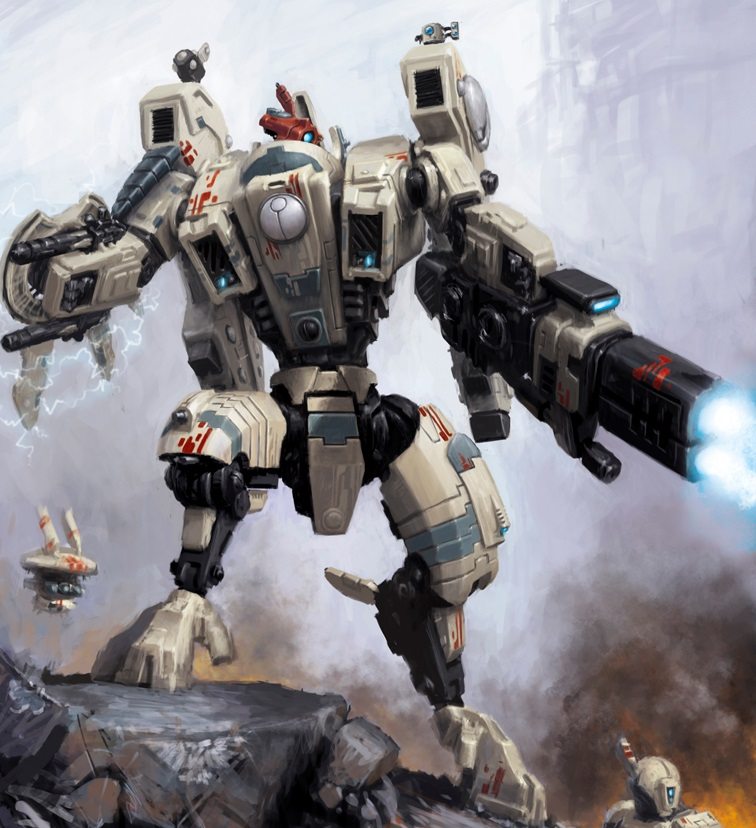
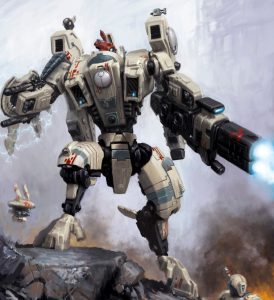
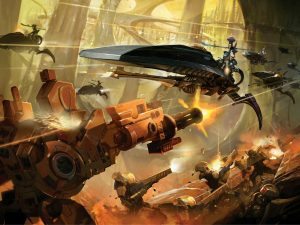
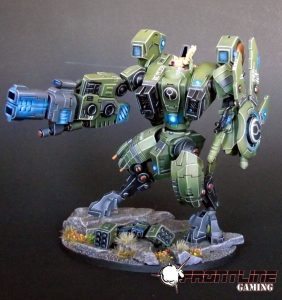
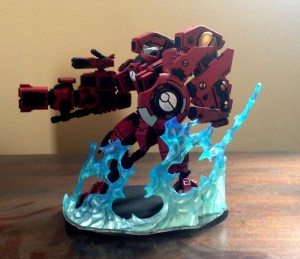
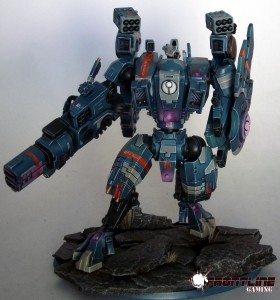
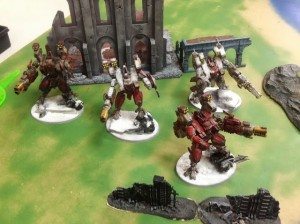
I love the riptides they have never failed me and when something does happen it’s usually my fault. FNP has saved my riptides more times then I can count however if people start using double riptide wings. It may not even be needed.
@abusepuppy
Will you do a review of the XV-109 y’vharra. Anyone who loves riptides would love these guys
They are the fastest hardest hitting unit in the tau army. Excluding the supremacy suit [cough] #letthebigsuitin
They are not without fault tho limited range and less wounds but it’s worth a look at
One of the other writers has already done a review of the Y’vahra, but I may get around to doing my own at some point as well.
I had a hard time going through this after you wrote that it’s basically an overpriced Leman Russ. The rest that you write out is good, but my god that first line just about lost me.
So, Leman Russ’ get to overwatch when nearby IG get charged? They get twin-linked stuff without Pask around? They can’t be one-shot-killed with penetrating hits from Meltas out a drop pod? They can jump-shoot-jump? They have AP2 pie plates? They have an option to fire their main gun at a lower power so they can also fire their other weapons at full BS? They can increase their BS? They have a 2+ save? They have a 4++ Inv? They have 5HP?
Like, the list is huge. That was a terrible, terrible comparison. The best comparison in the game to it that I can think of are Obliterators, since like an Obliterator, the Riptide can be good against anything and Obliterators are moderately tough. No where near as tough or fast as a Riptide, but that’s the closest I can think of.
Most importantly, is there an easily ally-able Lehman Russ Wing formation that allows for a turn of double firepower, increases their BS from 3-4, and dramatically reduces their only weakness (nova rerolls)? A solo Riptide in a Tau CAD may have firepower comparable to a LR (with greatly enhanced survivability and mobility), but nobody plays that. Everyone puts a Riptide Wing into Tau, or even guard. Why bring 3 Lehman Russ when you can just bring a Riptide wing?
The Riptide was in extensive use long before the Riptide Wing was ever printed, and people complained about it then as well. While the Riptide Wing is certainly very relevant to tournament play and important to understand- hence why I wrote an entire article about it- that’s not what I was writing about here, and not critical to understanding the Riptide itself. People _do_ take Riptides solo all the time, either in CADs or in formations like the Retaliation Cadre.
Also, if you’re not aware, there ARE options available for the Leman Russ that can significantly increase its firepower, such as Commander Pask or Beasthunter Shells. I think it’s hard to argue they’re as good as the Riptide Wing, but they can still be strong options that can compete at middle-tier tournaments of 20-70 players.
The point was that the actual firepower output from the two is very similar- a Leman Russ firing its three Heavy Bolters (even snapfiring) puts very nearly as much damage on a target as a Riptide does- AP2 is only relevant against a small subset of targets. Yes, the Riptide’s guns are more flexible, and the Riptide itself has many other advantages that I spend a significant amount of time discussing in the article, but the vast majority of the time the damage output from the two is going to be very similar, far more than most people would like to admit because the Riptide is “good” and the Russ is “bad.” The illustration was to show that this is NOT a result of the actual guns or firepower of the two units, despite common belief, but the other factors discussed.
(Markerlights, as an external consideration, are worth thinking about when building an army but not when comparing the two units in a vacuum. You could just as well cite the Russ’s ability to be the target of friendly psychic buffs, or the presence of blob squads to bubblewrap it as advantages for the Russ.)
I don’t know, it’s still a hard sell.
I mean, I -get- it, don’t get me wrong, but I don’t think it’s wise to discount the massively increased survivability or mobility of the Riptide so readily. While it is quite true that both of them can do very similar damage, the Leman Russ can’t do any damage at all if it’s dead. Sure, they play out extremely similarly if they don’t move and just shoot at an immoble squad of Guardsmen that never fires back, but that’s not so much evaluating them in a vacuum as it is in the cold void of space. If anything, it just proves that the Riptide is better in a game of Imperial Knight: Renegade than the LRBT.
That being said, the Riptide is strong and a little undercosted, but isn’t quite as bad as a lot of people make it out to be. If anything, it’s the Riptide Wing that’s the problem, since the Riptide has very clear weaknesses which are essentially invalidated by the formation (limited FOC slots, middling BS, nova reactor wounds, etc).
Mobility, survivability, and melee capacity are all really, really important to the Riptide. That’s why I dedicated several paragraphs to talking about them in detail, and explaining why they (and not the supposed “superior firepower”) are what makes the Riptide valuable.
The Riptide on its own is a good unit, but far from a top-tier or broken one. The Riptide Wing is a strong formation, but even it hasn’t been good enough to get Tau winning the truly big tournaments. I think Eldar, Daemons, Renegades, and Space Marines all have Tau beat pretty easily for top tournament performance.
I have recently been taking a single drone with my riptide in the Retaliation Cadre. Put the drone down first when deep striking and then arrange the riptide at any point around the drone’s base. I haven’t spotted anything in the rules that says this is problematic. I’ve already avoided several deep strike mishaps. Not exactly competitive but I enjoy it.
A homing beacon is better but sometimes one’s opponent has the gall to kill them all.
I’ve never done it with a Riptide, but I do that all the time with my Crisis/Broadside units- it’s entirely legal.
The Tau beacons are nice because you don’t have to wait a turn for them to be “active”- they work as soon as they’re on the board, so if even a single one of your Stealth Suits or Tetras arrive that turn, you’re golden.